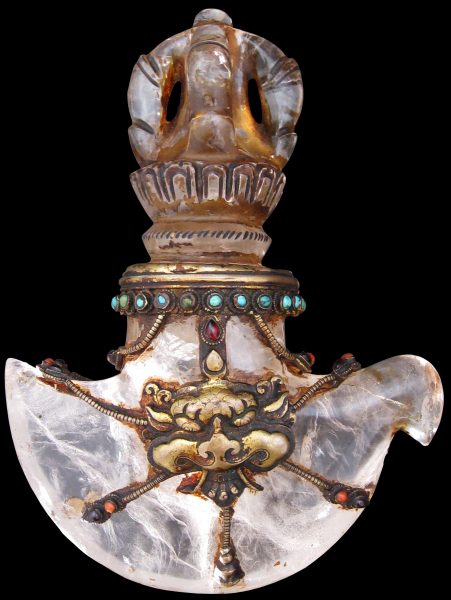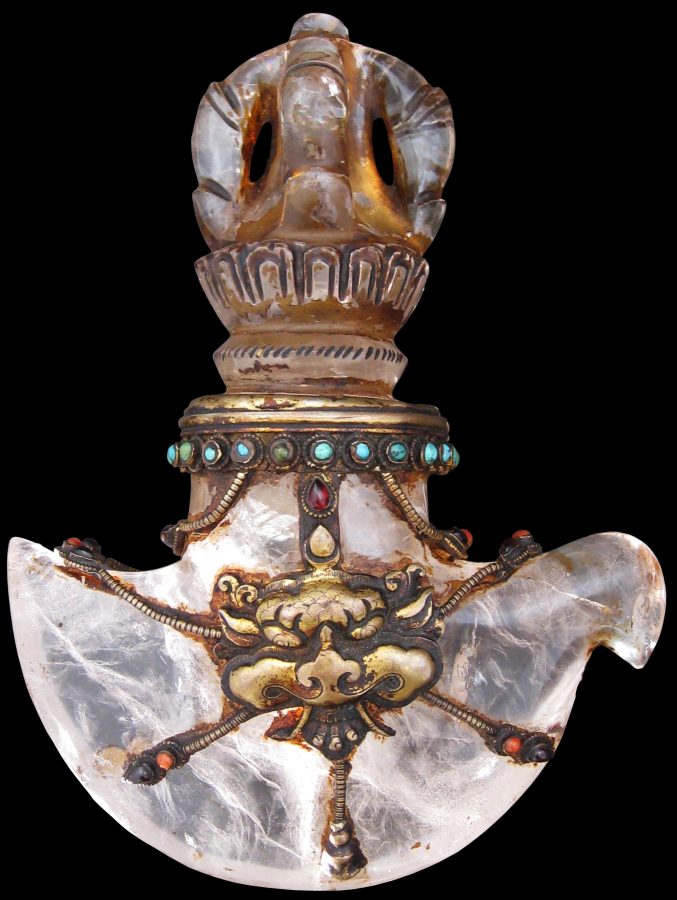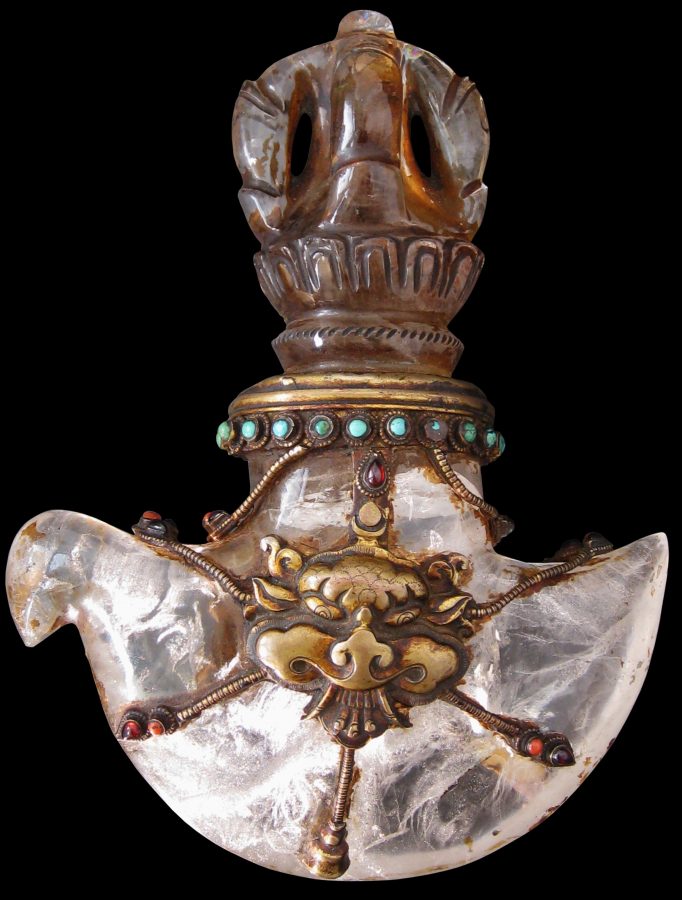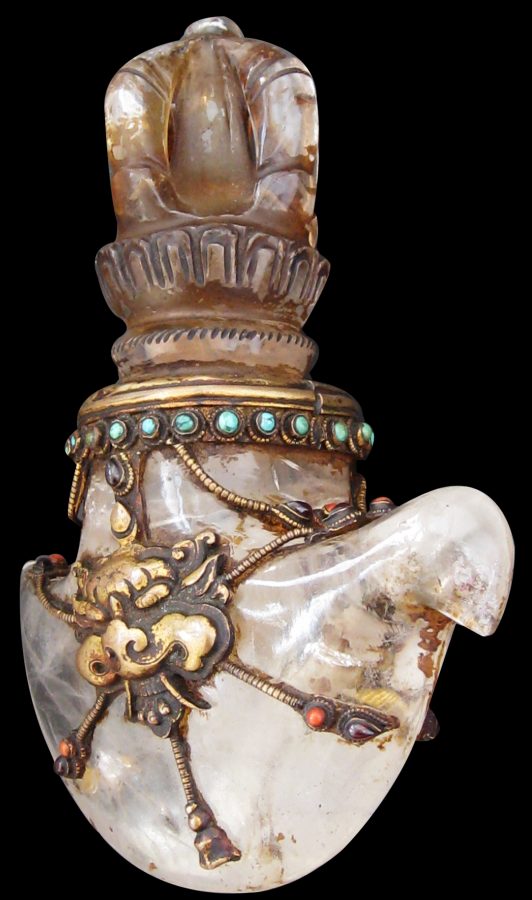This striking ritual crescent-shaped chopper or flaying knife is composed of a single piece of craved rock crystal with gilded brass mounts set with turquoise, coral and other stones. The crystal is particularly beautiful on account of the many inclusions contained within which catch and disperse the light. The contrast between the translucent crystal and the richness of the gilded mounts makes this ritual weapon especially attractive.
The blade of the chopper is decorated on both sides with akirtimukha face – the face of glory or majesty. (Technically, the face appears to be more like that of a lion in which case it is more properly known as a simhamukha face.) The face is depicted without a lower jaw, as is typical of Tibetan renderings of this face which has variants across South and Southeast Asia. Three jewels are shown on the extended tongue and strings of jewels are shown emitting from the face.
Thevajra copper is common attribute of the fiercest deities in the Tibetan Buddhist pantheon. The blade itself symbolises the wisdom of voidness that cuts through the knots of ignorance. The handle of this example comprises a five-prong vajra or thunderbolt.
Usually, ritual choppers are made of metal alone. It is unusual for them to be made from rock crystal, although an earlier rock crystal example is illustrated in Pal (1990, p. 246).
At one point the chopper was coated in a yellow pigment and animal glue mix but this has now largely worn away. It is not unusual in the Buddhist world for religious objects and images of deities to be made of precious material and then to have them covered with gilding or some other colouring in lieu of gilding. When items are viewed purely on aesthetic grounds then this practice may not make sense but these objects are first and foremost items of a religious nature. The use of precious material in the first instance is an act of merit. To then cover this material with gold leaf or a coloured pigment is a further act of merit.
A Tibetan ritual dagger (phurbu) made entirely of rock crystal, attributed to the 17th-18th century and 25.5cm long which comprised Lot 13 in Sotheby’s New York, ‘Indian, Himalayan, South-east Asian and Indian Miniatures’ sale of September 20-21, 1985, similarly seems to be have been coated but with much of the coating having worn away. Sometimes images of bodhisattvas in translucent jade were entirely covered in gilding in Ming China, and some Buddha images in Burma today are so entirely covered in gold leaf and other material that the original material has become entirely obscured and the shape of the image distorted.
The use of inlaid stones and the form of the metal work suggests that the chopper possibly was made by Newar craftsmen operating in Tibet, possibly in the Gyanste region. (Ethnic Newars have their origins in the Kathmandu Valley.) The use of the kirtimukha face or mask is also another pointer to Newari craftsmanship: the image is particularly popular with Newar craftsmen.
Examples of Tibetan items that use rock crystal in whole or in some significant part include:
– altarpieces in rock crystal with gilded copper mounts with heights varying from 20.6cm to 50.8cm and which were attributed to the 17th-18th centuries which comprised lot 4 in Sotheby’s New York, ‘Indian and Southeast Asian Art’;
– a rock crystal hookah base with gilded copper mounts, 29.8cm tall and ascribed to the seventeenth-eighteenth century, comprised lot 5 in the same auction;
– a gilt and silvered iron sceptre with a rock crystal head shaped as a skull, 38cm long, attributed to the fifteenth century, which comprised lot 92 in Christies’ Amsterdam, ‘Indian, Himalayan and Southeast Asian Art’, November 18, 1996;
– a gilded copper and rock crystal stupa, 33.5cm tall, ascribed to the Qing Dynasty (1644-1911) in the Tibet Museum and illustrated in Shanghai Museum (2001, p. 128);
– a set of three ritual weapons – aphurbu, a chopper and an axe – in gilded bronze and rock crystal, ascribed to eastern Tibet and to the seventeenth century or earlier, ranging from 20.3cm to 22.5cm in length in the Los Angeles County Museum of Art and illustrated in Pal (1990, p. 246);
– a water ewer of rock crystal with silver mounts and precious stones, ascribed to the eighteenth century, 29.2cm tall, n the Los Angeles County Museum of Art and illustrated in Pal (1990, p. 249);
– a ritual dagger (phurbu) of rock crustal, jade and gilded copper, ascribed to central Tibet, circa 1700, 62cm long, in the Art Institute of Chicago, and illustrated in Pal (2004, p.271);
– a ritual dagger (phurbu) of rock crystal, attributed to the 17th-18th century and 25.5cm long which comprised Lot 13 in Sotheby’s New York, ‘Indian, Himalayan, South-east Asian and Indian Miniatures’ sale of September 20-21, 1985, and lot 314 in Sotheby’s New York, ‘Indian and Southeast Asian Art’, September 19, 1996;
– a pair of rock crystal frogs with gilt copper bases, 15.2cm long, ascribed to the 19th century and which appeared as lot 198 in Sotheby’s New York, ‘Indian and Southeast Asian Art’, September 16-17, 1998; and
– a pair of silver mounted rock crystal ewers, ascribed to the 19th century, 33.3cm tall, and included in the same sale as lot 199;
There is a wide variation of datings ascribed to Tibetan rock crystal items. But with the patina on the gilded copper mounts of the chopper here a dating of around the first part of the nineteenth century is suggested.
This item was obtained from the Scottish art market. It is not unusual for South Asian and associated items to be sourced from Scotland. Many Scots were employed in the Indian colonial administration and today many families in Scotland and the English border areas retain colonial keepsakes.
References
Pal, P., Art of Tibet, Los Angeles County Museum of Art, 1990.
Shanghai Museum, Treasures from Snow Mountains: Gems of Tibetan Cultural Relics, Shanghai Museum, 2001.
Pal, P., Himalayas: An Aesthetic Adventure, The Art Institute of Chicago, 2004.
Beer, R., The Encyclopedia of Tibetan Symbols and Motifs, Serindia, 2004.





